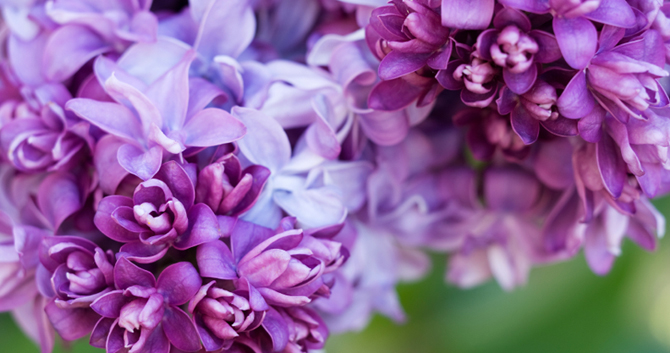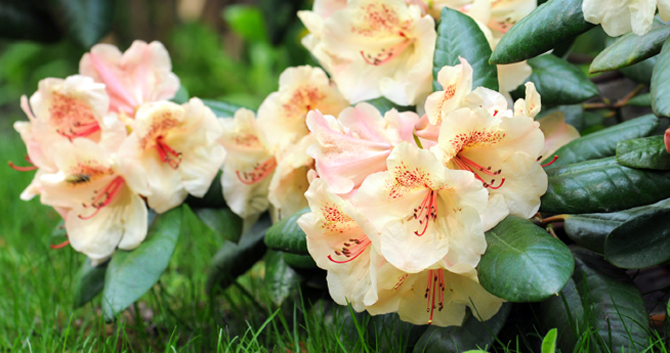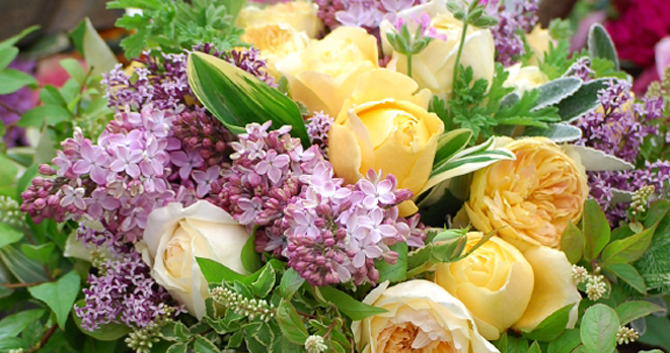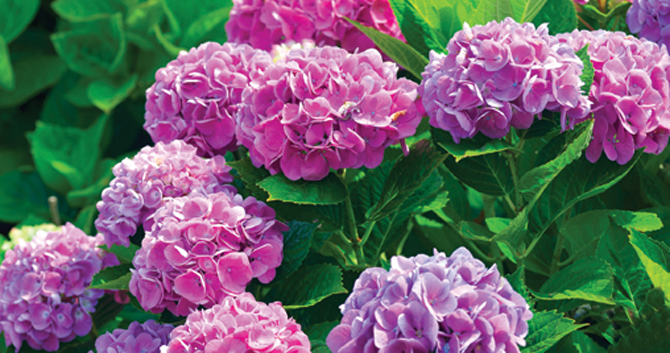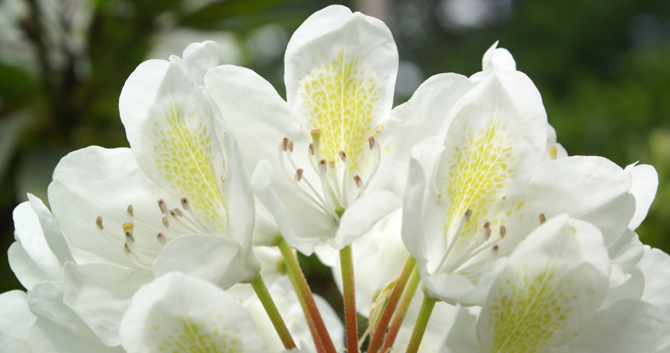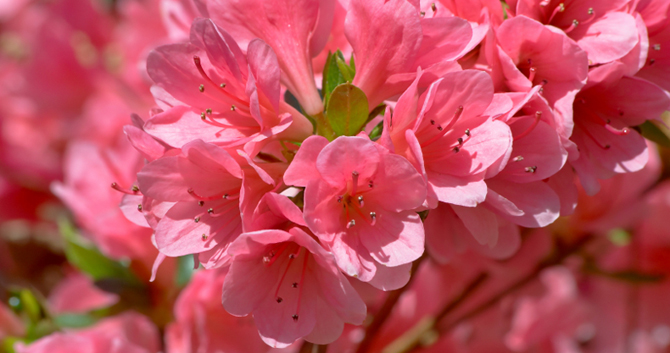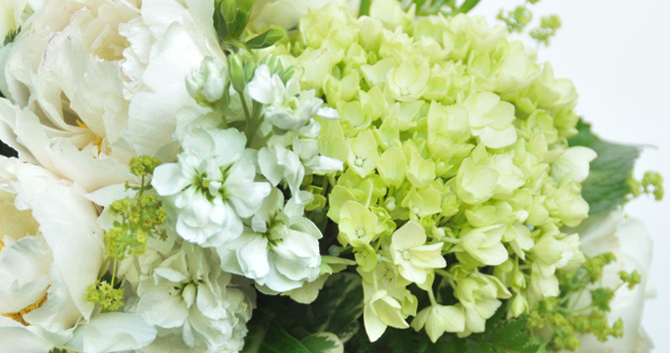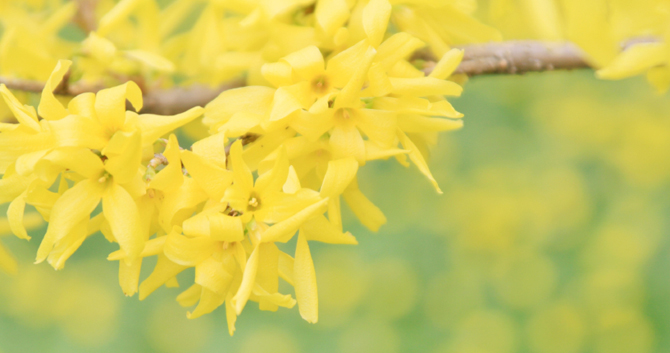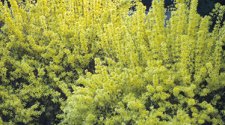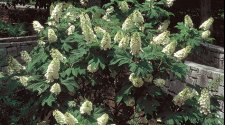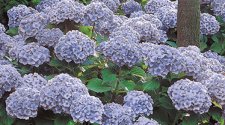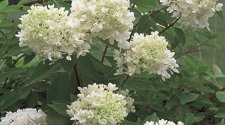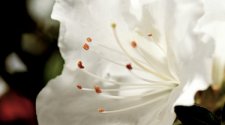What could be better than welcoming spring with an explosion of color, strolling through a garden wafting with fragrance, watching a butterfly flutter from flower to flower on a warm summer day, or picking armfuls of showy flowers to bring inside and set on a table? Flowering shrubs have all this on a grand scale, adding color and fragrance to a yard or garden, privacy and beauty to a patio or pool, softness and style to foundations, walkways, and driveways.
Among the seemingly infinite array of flowering shrubs available at the garden center, several stand out for reliably delivering an abundance of blooms while asking little in return other than modest pruning and occasional feeding. Azaleas, rhododendron, lilacs, mock orange, forsythias, hydrangeas, and spirea are among the most popular flowering shrubs combining attractive foliage with dense beautiful flowers.
Gardeners wait impatiently all year for the first blush of color on these garden celebrities and linger outside enjoying weeks of continuous blooms dripping from every branch. Dedicated enthusiasts hoping for a few more weeks of peak bloom time, not willing to concede that beauty is fleeting, are now raving about new varieties of azaleas, lilacs, rhododendron and hydrangea that bloom all summer or rebloom later in the season for continuous color until the fall.
Azaleas
Azaleas, nicknamed “royalty of the garden” are iconic of spring, blooming from April through May with masses of colorful flowers ranging from pure white and pastel yellow to salmon, orange, pink, red, and purple. Perfect for shady areas where most flowering plant struggle, they thrive under trees or along the northern side of the house.
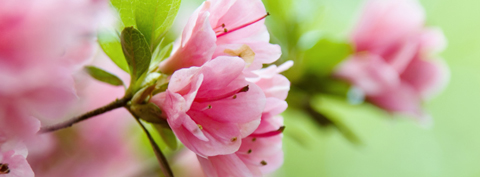 Azaleas welcome spring in colors ranging in a multitude of different colors
Azaleas welcome spring in colors ranging in a multitude of different colors
Planted alone or in masses, azaleas are unparalleled when it comes to show stopping vivid color. They pair perfectly with spring flowers like tulips, daffodils, allium, hyacinth, or creeping phlox to create a joyful garden that lifts the spirits watching nature reemerge from winter. Once the flowers have faded, azaleas make an excellent shrub with small densely packed leaves that offer a nice backdrop for summer flowers. They finish the season with a modest display of fall color when their leaves turn yellow, crimson, or purple.
For the avid azalea lover longing for more than a spring fling, the Encore Azalea is just the ticket. They begin their performance in early spring with a bold display of color, then prepare for a second act by sending out new shoots with buds that open in a spectacular fall performance, finally dropping the curtain with leaves that turn color at the onset of winter. With 25 varieties in a range of sizes and colors, these cold tolerant shrubs make them the ultimate bookends for continuous garden color. Imagine pairing a soft lavender azalea with ornamental kale, a blazing red azalea under a fall tree awash in orange, or a glowing white azalea underplanted with golden yellow mums. At last, the possibilities for fall landscaping are now virtually endless.
Rhododendron
Rhododendron (meaning rose tree) are in the same family as azaleas but take things to a whole different level. If azaleas are garden royalty, rhododendron are “the king of shrubs” regarded by many as the best flowering evergreen plants for temperate landscapes. They can grow to be large bushes, reaching heights of 8 to 15 feet depending on the variety. Their large leathery leave surround flower clusters the size of grapefruits in white, yellow, orange, red, pink, and purple that bloom in May into June depending on the variety and region.
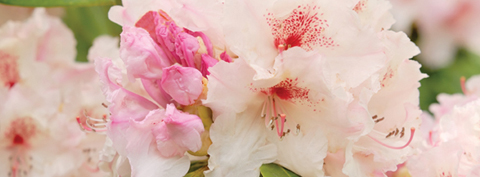 Upon close inspection rhododendron reveal an intricate beauty with contrasting freckles and graceful stamen
Upon close inspection rhododendron reveal an intricate beauty with contrasting freckles and graceful stamen
They make irresistible cut flowers, instantly creating dramatic bouquets with only two or three stems, combining beautifully with lilac, azaleas, dogwood, viburnum, magnolia, tulips, and narcissus. Rhododendron can be forced indoors in late winter, bringing spring color to life before Mother Nature wakes up. Simply cut branches tipped with swollen flower buds in February and immediately place them in water. They’ll bloom in 3 to 6 weeks with flowers lasting five to ten days.
Lilacs
Who can resist the allure of lilacs? Easy to grow in full sun, few flowers compare to lilacs in full bloom, their sprays of flowers in chalky shades of lavender, pink, white, cream, or yellow gracefully swaying in the breeze, their intoxicating floral notes perfuming the garden. A member of the olive family, lilacs were brought from Europe by early settlers who couldn’t bear to part with this remembrance of home. Today, lilacs still evoke loving childhood memories of mothers and grandmothers.
Lilacs are ideal focal points on their own but also pair well with other spring flowering trees and shrubs including crabapple, magnolias, dogwood, flowering cherry trees, peonies, azalea, and rhododendron. They work well at the rear of the garden adding height and greenery after flowering to showcases summer perennials and annuals. Lilacs also make excellent cut flowers, draping effortlessly over the sides of a vase, filling the room with the scent of fresh flowers. Alone or in mixed bouquets, few cut flowers compare to the ease and grace of lilacs.
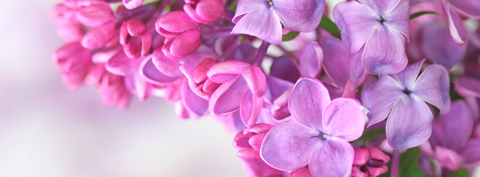 Lilac flowers emerge in chalky shades of pink, purple, and white from tight dark buds
Lilac flowers emerge in chalky shades of pink, purple, and white from tight dark buds
Growing lilacs requires some patience. Lilacs need three to four years to mature before blooming. Transplants usually take a break from blooming for a year after being moved. But once established it’s worth the wait - they’re hardy, prolific bloomers that won’t disappoint. Most lilacs are covered in blooms for several weeks in the spring although some varieties do bloom later in the season into early summer. Combining several varieties with different bloom times can extend the enjoyment for up to six weeks. Alternatively, try new reblooming varieties like Bloomerang and Josee which bloom first in early spring and again from mid-summer until frost.
Lilacs generally grow to 8- to 12 feet, offering great summer shade and privacy. Flowers emerge mostly at the top, so prune taller varieties to keep blooms within reach. Lilac buds form on old wood soon after the flowers die back, so prune early before new buds emerge. Pruning in summer, winter, or early spring will remove the buds that become next year’s flowers.
Cutting armfuls of fragrant lilacs to bring inside to perfume your rooms is one of the best ways to promote blooms the following spring. Dwarf lilacs are available that only grow to about four feet, remaining compact and carefree. These are perfectly scaled for container plantings, borders, entryways, and small spaces, adding color and attracting butterflies with their sweet fragrance.
Forsythia
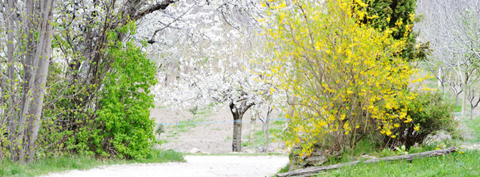 Forsythia emerge in early spring weeks before other flowering plants
Forsythia emerge in early spring weeks before other flowering plants
As one of the earliest spring bloomers, forsythia ranks second only to the groundhog as the true harbinger of spring. Its bell-shaped flowers burst from bare stems to create fluttering wands of early color when most plants are still dormant. Forsythia are durable, vigorous, deer resistant plants that thrive in full sun. Their arching branches create a casual and effective privacy screen after flowers fade and leaves emerge.
Best known for its golden color, forsythia varieties also include a delightfully fragrant white variety (Abeliophyllum distichum) and a subtly hued soft pink variety (Abeliophyllum distichum 'Roseum').
Forsythia branches can be easily forced indoors in late winter to help gardeners impatient for spring to get a burst of color just when the wait seems interminable. Just snip a few sprays on a day when the weather is above freezing, soak the stems in warm water for a few hours, then arrange in a vase with fresh water.
Hydrangea
While most flowering shrubs bloom in the spring, hydrangeas wait until mid-summer and then continue through the fall, making them indispensable for energizing a garden. Common types include Bigleaf, PeeGee, Oakleaf, and Annabelle, each having different features suited to individual tastes. Most prefer morning sun and afternoon shade but some thrive in full sun. All make spectacular cut flowers and dry beautifully for winter arrangements in wreaths, baskets, containers, or window boxes. They are a favorite among brides and wedding planners for bridal bouquets and table centerpieces.
Bigleaf hydrangeas (hydrangea macrophylla) are garden classics with flowering pom-poms in shades of white, pink, blue, and purple. Newer lacecap varieties have delicate flat flowers in similar shades floating above dark green foliage. Both pair perfectly with heirloom flowers like monkshood, day lilies, delphinium, lupine, and weigela to create a cottage garden that will be the envy of the neighborhood. Can’t get enough of these showy flowers? Look for reblooming varieties like Endless Summer and Forever & Ever which bloom continuously from June through September.
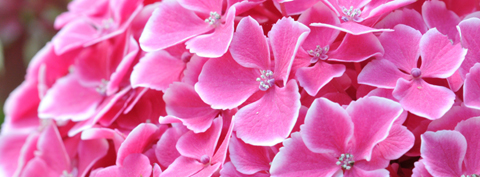 Hydrangea are the star of the garden from mid-summer through the fall
Hydrangea are the star of the garden from mid-summer through the fall
Known as chameleons of the garden world, Bigleaf hydrangeas change from pink to blue in alkaline soil and from blue to pink in acidic soil. Only white varieties lacking pigment can’t be coaxed into changing color. To change from pink to blue, add aluminum sulfate, lower the pH with grass clippings or coffee grounds, and apply a 25/5/30 fertilizer high in potassium and low in phosphorous. To change from blue to pink, add dolomitic lime, apply a 15/10/10 fertilizer high in phosphorous and low in potassium, and further boost the phosphorous with bone meal or superphosphates.
PeeGee hydrangeas (Hydrangea paniculata) are also extremely popular. They thrive in full sun where other varieties wither and are the only hydrangea that can be shaped into a small tree. Their pink buds open to large creamy white conical flowers which gradually fade to shades of pink and finally to brown. Their large dramatic blooms contrast nicely with sun loving perennials like astible, delphinium, lupine, daylilies, and butterfly bush.
Oakleaf hydrangeas (Hydrangea quercifolia) are as prized for their spectacular fall foliage in deep shades of burgundy, red, orange, or yellow as they are for their large white flowers. Along with Annabelle hydrangeas (Hydrangea arborescens) they’re native to the United States and pair well with hostas, foxgloves, and other shade tolerant plants.
Spirea
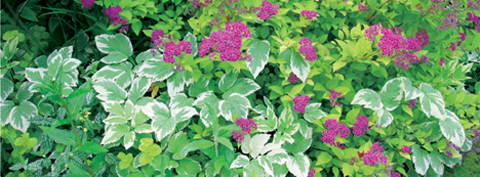 Spirea pairs well with silvery foliage like aegpodium
Spirea pairs well with silvery foliage like aegpodium
Spirea are carefree shrubs that froth with white, yellow, pink, or red flowers in late spring to early summer. Their profuse small flowers and bright airy foliage contrast beautifully with silver grey foliage plants like hosta, sedum, or aegopodium and purple-toned perennials like dutch iris, Russian sage, butterfly bush, or daylilies. They’re irresistible to butterflies and honeybees but resistant to deer. They thrive in full to part sun with little attention. Low growing varieties like Japanese spirea looks great along garden walls, in rock gardens, containers, or walkways. Taller varieties like bridal wreath spirea are great anchor plants for foundation plantings.

